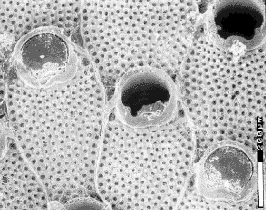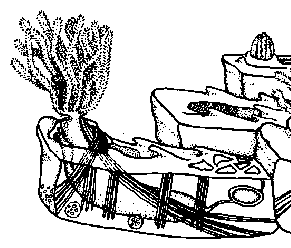



Bryozoa: More on Morphology
 Almost all bryozoans are colonial, composed of anywhere from a few to millions of individuals. This skeleton of a living bryozoan, collected at Bahia de los Angeles, Baja California, clearly shows this typical colonial organiation. Each
individual, or zooid, is enclosed in a sheath of tissue, the
zooecium, that in many species secretes a rigid skeleton of calcium
carbonate.
Each zooid in this electron micrograph is less than a
millimeter long and has a single opening, the orifice.
Through this opening, the
lophophore,
a ring of ciliated tentacles centered on the mouth,
protrudes to capture small food
particles. The lophophore can be retracted very rapidly by
specialized retractor muscles, and the opening closed by a
doorlike operculum, visible on some of the zooids in the picture
at the left. Image taken using the UCMP Environmental Scanning Electron Microscope. |
 The mouth opens into a U-shaped gut; the anus is located just outside
the lophophore. From this arrangement comes the alternative name for the
Bryozoa, the Ectoprocta (Greek, "anus outside"). The body also contains a
coelom and gonads; there is a small central ganglion, or "brain," but no
specialized excretory or respiratory systems.
Zooids are usually connected to each other by thin strands of tissue.
The mouth opens into a U-shaped gut; the anus is located just outside
the lophophore. From this arrangement comes the alternative name for the
Bryozoa, the Ectoprocta (Greek, "anus outside"). The body also contains a
coelom and gonads; there is a small central ganglion, or "brain," but no
specialized excretory or respiratory systems.
Zooids are usually connected to each other by thin strands of tissue.
In most bryozoans, several different types of zooids coexist in a colony, each one specialized for a particular function. Feeding zooids like the ones described above are known as autozooids, whereas specialized nonfeeding zooids may be called heterozooids. Heterozooids are dependent on functioning autozooids for nutrients. Heterozooids include forms specialized for producing and brooding eggs, or, more rarely, sperm. Avicularia are small heterozooids in which the zooecium and operculum form a beak-like, snapping structure that deters small predators. Vibracula bear long setae, or bristles, and are thought to function in cleaning the bryozoan colony, while kenozooids are small heterozooids that strengthen and support the colony as well as fill space. In conclusion, bryozoan colonies show a range of integration. The most integrated colonies behave like individual organisms, for the zooids making up the colony are all specialized for certain functions and connected to each other. |
|
Encrusting bryozoans form flat sheets that spread out over rocks, shells, and other substrates. Forms that grow upwards into the water column may be massive (solid), foliaceous (sheetlike, with zooids on both sides), dendroid (branchlike or treelike), or fenestrate (many branches joining and rejoining to form a netlike or "windowed" shape). Erect forms were much more common in the Paleozoic than they are now; the majority of today's bryozoan species are encrusting. Some bryozoans strengthen their skeletons by producing large amounts of extrazooidal material, which is formed outside the zooids themselves. The enormous masses of jelly-like material produced by some freshwater bryozoans are extrazooidal, as is the calcareous skeleton produced by many stony species, including this Pennsylvanian fenestrate bryozoan, Archimedes, seen to the left and the right. |


